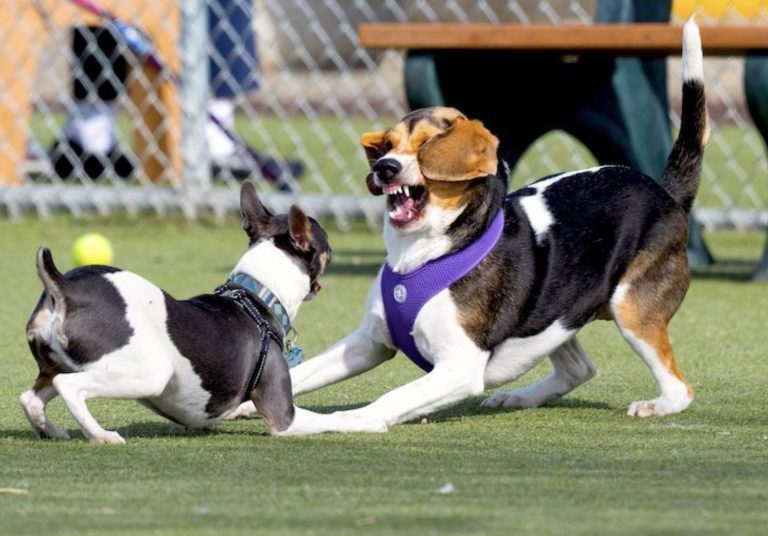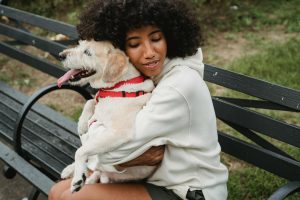Do you have a dog that is nervous on walks around other dogs? Does your dog get anxious when you approach other dogs? There can be different reasons why your puppy is nervous. Bad behavior and bad training are two of the things any dog owner would love to avoid.
The first mistake owners make is to label their dogs. Labeling your dog is a crutch that allows for bad behavior and permanently prevents your dog from enjoying a happy life. You should not punish your dog by not letting him sniff other dogs.
And if your dog is nervous, you might get into a vicious cycle of stopping him from interacting and socializing with other dogs. He gets more and more nervous and you end up with a dog that cannot be around other dogs.
The first thing you need to understand is that your dog is not only nervous. Your puppy is sending you a message, giving you information.
There are three big reasons why your pet might be nervous. The first one is a lack of proper socialization. The second is anxiety from the rest of their life just leaking out. And the third one is an owner not advocating for their dog properly.
We will get into each of these reasons separately and how to fix the problem with your puppy.
Reason Number 1 – Lack of proper socialization
Socialization is a big part of dog training and dog behavior. You want to do a couple of things to properly socialize your dog. But the most important thing you can do is meet your dog with friends and well-behaved dogs.
In the first few months of your dog’s life, you should not risk it with dogs that do not behave properly. Ask your friends who have good dogs to hang around and meet with supervision.
You can start in your backyard, where the two of you can call one of the dogs away and the puppies can play calmly. You can also go on relaxed walks together without playing and jumping.
The thing you want your dog to understand is they can live in existence with other dogs. This is much easier with a well-balanced dog. It is hard to do with a bad dog (there is no bad dog, but only a badly trained or untrained dog). At the end of the day, you are better off meeting 0 dogs than 10 bad dogs.
The second thing you can do for socialization is to go past good dog hotspots. For example, places where there are dogs laying calmly. You can just pass these places (think of Starbucks or outdoor restaurants). You pass, your dog sniffs, and you continue your walk.
The third way to socialize your dog is to go on a walking trail where there are usually well-behaved dogs. You can also try some dog obedience meet-up groups. Just do not make the mistake of going to the dog park and letting your dog roam free with 10 other dogs.
At the end of the day, you want as many positive neutral encounters as possible. When your dog gets lots of positive neutral encounters, he learns he can live in existence with other dogs. Then you can start having him play.
Reason Number 2 – Anxiety
So, now we get to the point of anxieties. Dogs can have anxieties about different things. Some dogs are afraid of stairs. Others are afraid of big objects during the walk.
And then there are dogs that are just trying their best to get out of the leash during walks. All of these reasons are legit for fear, anxiety, and being nervous around other dogs on walks.
What you want to do here is improve your dog’s reliability and build up your dog’s confidence. It is a long process and you need to work on it every day.
Addressing common dog anxieties, such as fear of stairs or apprehension during walks, is crucial for fostering your dog’s well-being. Consistently improving your dog’s reliability and confidence is a daily and essential process.
For example, if your dog is afraid of stairs, try positive reinforcement with stairs in your building. Do not push your dog, let him move up and down on his own terms. You can only lure him and reward positive behavior.
Obedience training is a very important step to having a calm and confident dog. The Number 1 thing you need to remember is that you should make sure your dog WINS every single day.
What does that mean? Well, it means that you should put your dog in a position where he can win (perform positively) and reward that behavior. If you push your dog to do something he is not comfortable with, you are putting him in a position to lose. And that starts a cycle where you yell at your dog, punish him or whatever, and your dog’s confidence goes lower and lower.
You need a structure where you reward every little step your dog makes.
Reason Number 3 – Advocating for your dog
So, this is one mistake most dog owners make. Your dog should look at you as a leader. And should follow you. Your dog wants to follow you and take direction from you. But in order to do that, your dog needs to understand it is safe around you. What is a GOOD LEADER? One that leads with CONFIDENCE and he is CALM all the time.
To put this in perspective. You walk with your dog, and you see another dog approaching. What you will do at that moment will reflect how your dog will react to the situation. If you start panicking, your dog will sense your fear, panic, and anxiousness and react accordingly.
Another mistake owners make is they take their dog to a dog park before your puppy looks at you as a leader. The moment you enter the dog park, there will be more than 20 dogs there. And your pup will feel overwhelmed. Dogs will come sniffing him/her, some will want to play, and he will try to hide behind you. And you, as a dog owner, might try to push him to play. WRONG.
You do not want dogs running toward your puppy when he has yet to build confidence and learn how to interact with other animals. Do not force your dog to hang out with other dogs until he/she feels confident to do that.
What should you do to prevent anxiousness on walks?
In another article I’ve talked about a trick you can use to prevent dog-dog reactivity on walks. Remember, dog nervousness is not a disease. It is not a condition.
Do not expect things to change out of themselves. If your dog is nervous around other dogs, you have to find the root of the problem.
Talk to a dog trainer or dog behaviorist. One trick you can use is the stimulus blocking technique. It is the article I referred to before.
Basically, the trick is to block the stimulus that prompts your dog to react on walks, to bark, and to be aggressive.







